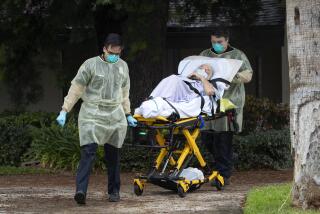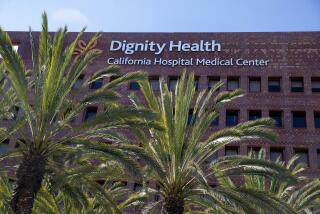Medicare Deaths Up at 44 State Hospitals : Health: The number includes Placentia Linda Community. Twelve California institutions had lower than predicted rates, an annual study finds.
- Share via
More than 40 California hospitals, including one in Orange County, had significantly higher than predicted death rates for Medicare patients in 1989 and 12 state institutions had significantly lower than predicted death rates, according to the U.S. Health Care Financing Administration’s fourth annual report on Medicare mortality at the nation’s hospitals.
Two of the 44 California hospitals with higher than predicted death rates--American River Hospital in Carmichael and Martin Luther King Jr./Drew Medical Center in Los Angeles--are also among the 15 hospitals nationally that have had high mortality rates for four consecutive years, according to the federal report. This list also includes six hospitals in Puerto Rico and Harlem Hospital in New York City.
Officials at American River and Martin Luther King defended their quality of care in letters to the health care administration that were published as part of the report.
Administrator Gail R. Wilensky cautioned that the statistics--compiled over 12 months ending in September, 1989--are intended as a screening tool to identify potential problems and to help patients ask questions of their physicians, not as a direct measure of the quality of care. “We believe that being on these lists indicates a reason to give a closer look,” she said. “(But) it is not a clear or necessary indication that care at these facilities was substandard, or that these hospitals are performing poorly in the way they provide health care.
“Mortality is not the only measure of quality, as well it ought not to be.”
In Orange County, Placentia Linda Community Hospital also made the federal list of Medicare hospitals with high mortality rates.
According to the federal report, 15.7% of 523 patients died in 1989, while the expected percentage of deaths for that many was only 10.2%
However, Placentia Linda officials emphasized that in every category of illness--from pneumonia deaths to deaths from stroke--federal officials had added the following disclaimer: “The number of cases or deaths in this category is too small to permit satisfactory estimation of the standard deviation.”
And Charlene Clark, the 114-bed hospital’s director of business and community relations, said the facility’s death rate was not unusually high for its community. “We have elderly. . . . We service a large cancer population,” she said.
Clark noted that hospital officials investigate every death. Also, she said, a review of the hospital last fall by the Joint Commission on Accreditation of Hospitals had found Placentia Linda “an excellent hospital.”
The hospital’s chief operating officer Russell Goldberg added that “mortality data, as it presently exists, are of limited value to the average consumer” because the federal rates do not take into account important variables like a patient’s age, the complexity of the case or whether a patient was admitted from a nursing home.
California hospitals with lower than predicted mortality rates included Cedars-Sinai Medical Center, Green Hospital of Scripps Clinic in La Jolla, Kaiser Foundation Hospital in Los Angeles, St. John’s Hospital in Santa Monica and UCLA Medical Center.
Medicare is the federal health insurance plan for the elderly and disabled. The mortality data is contained in a 25-volume report covering nearly 6,000 acute-care hospitals and containing statistics for fiscal years 1987 through 1989.
A hospital’s predicted mortality calculates a patient’s relative risk of dying, accounting for factors such as age, sex, chronic diseases and previous hospitalizations.
The federal report has been significantly improved over previous reports, according to Wilensky.
The key improvements are the listing of death rates for eight medical conditions and nine procedures that are common in the elderly, as well as the overall mortality rate and the listing of death rates within 30, 90 and 180 days after hospital admission. The conditions and procedures include angioplasty, heart attacks, heart bypass surgery, hip fractures, hysterectomies and prostate surgery.
Previous reports were limited to deaths occurring within 30 days after hospital admission and broad “diagnostic categories of illnesses that meant little to consumers.
After 30 days, the overall national mortality rate for Medicare patients was 9%, according to the report. At 180 days, it was 17.4%. Between 1985 and 1988, federal officials have seen a slight decline in the risk of death after hospitalization under the Medicare program.
Despite improvements in the statistics, many hospital officials and some health policy experts believe that the statistics still largely reflect differences in the sickness of patients cared for in different hospitals, not differences in the quality of care.
Edward J. Renford, administrator of Martin Luther King Jr./Drew Medical Center, said in a letter to the health care administration that Medicare patients represented only 5% of the hospital’s patients. “Clearly that sample of our patients cannot be used to characterize the quality of care,” he wrote.
In recent years, state and federal health inspectors have documented numerous quality of care problems at King. Many have been corrected.
Officials of American River Hospital, near Sacramento, stated “unequivocally” in a letter to the agency that “the quality of care . . . is not in doubt.”
The hospital said its death rates had been reviewed multiple times by independent groups of experts, with “no issues of quality” noted. About half the deaths were among patients with “do not resuscitate” orders because of the terminal nature of their illness.
The report can be obtained from the U.S. Government Printing Office in Washington, D.C., 20402; the telephone number is (202) 783-3238. The two California volumes cost $61.
MEDICARE DEATH RATES
When compared with their predicted 1989 death rates, these Southern California hospitals had the highest and lowest mortality rates for Medicare patients, according to the U.S. Health Care Financing Administration.
The data reflects the percentage of a hospital’s Medicare patients who died within 30 days of being admitted, whether as patients or after discharge. The national average 30-day mortality is about 9%.
Hospitals listed in boldface also had significantly high or low death rates for patients within 180 days after hospital admission.
HIGHER THAN EXPECTED MORTALITY RATES HOSPITAL PATIENTS PREDICTED ACTUAL DEATH RATE DEATH RATE AMI Valley Med. Center, El Cajon* 915 12.4% 15.8% Bakersfield Memorial Hospital 1,881 9.4% 11.9% Burbank Community Hospital 488 10.3% 14.1% California Med. Center, L.A.* 2,184 10.0% 12.8% Canoga Park Hospital 407 10.9% 15.7% Charter Comm. Hosp., Hawaiian Gardens* 2,245 7.8% 9.6% Friendly Hills Regional Hosp., La Habra 1,416 9.5% 11.7% Hemet Valley Med. Center* 4,665 8.1% 10.2% Inter-Community Med. Center, Covina 2,120 7.5% 10.4% Kern Medical Center, Bakersfield* 621 9.1% 12.6% Loma Linda Community Hospital* 909 10.1% 13.9% Long Beach Community Hospital* 1,672 10.3% 14.5% Marina Hills Hospital, L.A. 509 6.0% 9.6% M.L. King Jr./Drew Med. Center, L.A.* 378 11.2% 19.6% Medical Center of Garden Grove 1,133 13.0% 15.7% Midway Hospital Med. Center, L.A.* 2,199 12.3% 14.4% Parkview Community Hospital, Riverside* 1,925 10.6% 13.5% Placentia-Linda Community Hospital 523 10.2% 15.7% Pomona Valley Hosp. Medical Center* 3,362 8.5% 11.0% Redlands Community Hospital* 2,051 8.2% 13.7% Riverside Community Hospital* 2,457 8.6% 10.7% R.F. Kennedy Med. Center, Hawthorne 993 10.0% 13.2% San Bernardino County Med. Center* 493 9.9% 18.1% USC Kenneth Norris Jr. Cancer Hosp. 388 6.7% 11.1% Valley Hosp Med. Center, Van Nuys* 821 10.0% 12.9% LOWER THAN EXPECTED MORTALITY RATES Cedars-Sinai Med. Center, L.A. 7,295 8.8% 7.8% Eisenhower Mem. Hosp., Rancho Mirage 3,684 7.8% 6.7% Green Hosp. Scripps Clinic, La Jolla* 1,950 7.1% 3.9% Kaiser Foundation Hospital, L.A. 3,425 10.0% 6.9% St. John’s Hospital, Santa Monica* 3,517 8.6% 7.1% UCLA Medical Center* 2,991 7.5% 5.9%
NOTES: For each hospital, the HCFA calculated a predicted mortality rate and compared it to the institution’s actual mortality rate. The predicted mortality rate takes into account characteristics of individual patients. These include age, sex, previous hospitalizations, other chronic illnesses, emergency or non-emergency admission status, admission source, such as a nursing home or hospital transfer, as well as the number of patients treated at each hospital. When a patient had multiple hospitalizations within one year, one was chosen at random for analysis.
* An asterisk indicates hospitals that sent explanatory comments to the HCFA. There is a less than 5% probability that a hospital would be listed as having a high or low mortality rate because of chance.
Times staff writers Holly Hacker in Washington and Lanie Jones in Costa Mesa contributed to this story. Times researcher Tracy Thomas in Los Angeles assisted in preparing the chart.
More to Read
Sign up for Essential California
The most important California stories and recommendations in your inbox every morning.
You may occasionally receive promotional content from the Los Angeles Times.










